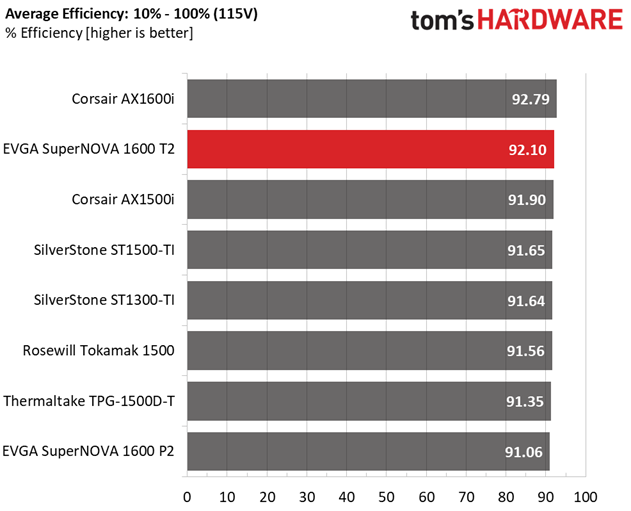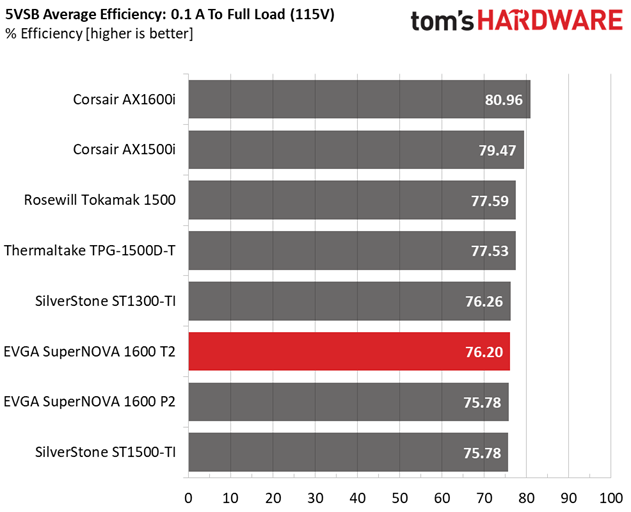EVGA SuperNOVA 1600 T2 PSU Review
Why you can trust Tom's Hardware
Efficiency, Temperature & Noise
Efficiency
Our efficiency testing procedure is detailed here.
Using results from the previous page, we plotted a chart showing the 1600 T2's efficiency at low loads, and loads from 10 to 110 percent of its maximum-rated capacity.




Under normal loads, only the fully-digital AX1600i beats EVGA's 1600 T2. Light loads keep the huge-capacity Super Flower platform close to its competition.
Efficiency At Low Loads
In the following tests, we measure the 1600 T2's efficiency at loads significantly lower than 10 percent of its maximum capacity (the lowest load the 80 PLUS standard measures). The loads we dialed were 20, 40, 60, and 80W. This is important for representing when a PC is idle, with power-saving features turned on.
| Test # | 12V | 5V | 3.3V | 5VSB | DC/AC (Watts) | Efficiency | Fan Speed | PSU Noise | PF/AC Volts |
|---|---|---|---|---|---|---|---|---|---|
| 1 | 1.183A | 0.496A | 0.481A | 0.197A | 19.551 | 64.514% | 0 RPM | <6.0 dB(A) | 0.809 |
| 12.215V | 5.037V | 3.326V | 5.084V | 30.305 | 115.34V | ||||
| 2 | 2.431A | 0.992A | 0.993A | 0.394A | 39.993 | 77.564% | 0 RPM | <6.0 dB(A) | 0.903 |
| 12.215V | 5.036V | 3.325V | 5.079V | 51.561 | 115.32V | ||||
| 3 | 3.605A | 1.490A | 1.474A | 5.075A | 59.435 | 82.933% | 0 RPM | <6.0 dB(A) | 0.937 |
| 12.215V | 5.035V | 3.324V | 5.075V | 71.666 | 115.29V | ||||
| 4 | 4.852A | 1.986A | 1.986A | 0.789A | 79.863 | 85.783% | 0 RPM | <6.0 dB(A) | 0.953 |
| 12.215V | 5.034V | 3.323V | 5.070V | 93.099 | 115.27V |
With 20W load, the efficiency we measure drops below 70%, and with 40W it fails to hit the 80% mark. Only with 60W and 80W loads does EVGA's 1600 T2 achieve >80% efficiency scores.
But for a platform getting up there in age, and given its high capacity, this PSU's efficiency performance under light loads is satisfactory.
5VSB Efficiency
The ATX specification, along with CEC, ErP Lot 3 2014 and ErP Lot 6 2010/2013, states that 5VSB standby supply efficiency should be as high as possible, recommending 75 percent or higher with 550mA, 1A, and 1.5A of load. The PSU should also achieve higher than 75% efficiency at 5VSB under full load, or with 3A if its max current output on this rail is higher than 3A.
Get Tom's Hardware's best news and in-depth reviews, straight to your inbox.
We take six measurements: one each at 100, 250, 550, 1000, and 1500mA, and one with the full load the 5VSB rail can handle.
| Test # | 5VSB | DC/AC (Watts) | Efficiency | PF/AC Volts |
|---|---|---|---|---|
| 1 | 0.100A | 0.509 | 69.441% | 0.041 |
| 5.085V | 0.733 | 115.27V | ||
| 2 | 0.250A | 1.271 | 76.474% | 0.091 |
| 5.082V | 1.662 | 115.27V | ||
| 3 | 0.550A | 2.793 | 78.654% | 0.180 |
| 5.076V | 3.551 | 115.27V | ||
| 4 | 1.000A | 5.069 | 79.777% | 0.278 |
| 5.069V | 6.354 | 115.27V | ||
| 5 | 1.500A | 7.591 | 80.286% | 0.350 |
| 5.060V | 9.455 | 115.32V | ||
| 6 | 3.000A | 15.092 | 79.094% | 0.457 |
| 5.030V | 19.081 | 115.36V |


Super Flower doesn't pay much attention to the 5VSB rail, so its efficiency isn't great (especially with 230V input).
Power Consumption In Idle And Standby
In the table below, you'll find the power consumption and voltage values of all rails (except -12V) when the PSU is idle (powered on, but without any load on its rails), and the power consumption when the PSU is in standby mode (without any load, at 5VSB).
| Mode | 12V | 5V | 3.3V | 5VSB | Watts | PF/AC Volts |
|---|---|---|---|---|---|---|
| Idle | 12.215V | 5.038V | 3.327V | 5.088V | 9.291 | 0.427 |
| 115.4V | ||||||
| Standby | 0.120 | 0.007 | ||||
| 115.3V |


Vampire power is quite high, exceeding 0.2W with 230V.
Fan RPM, Delta Temperature, And Output Noise
Our mixed noise testing is described in detail here.
The first chart below illustrates the cooling fan's speed (in RPM), and the delta between input and output temperature. The results were obtained at 37°C (98.6°F) to 47°C (116.6°F) ambient temperature.
The next chart shows the cooling fan's speed (again, in RPM) and output noise. We measured acoustics from one meter away, inside a hemi-anechoic chamber. Background noise inside the chamber was below 6 dB(A) during testing (it's actually much lower, but our sound meter’s microphone hits its floor), and the results were obtained with the PSU operating at 37°C (98.6°F) to 47°C (116.6°F) ambient temperature.
The following graph illustrates the fan's output noise over the PSU's operating range. The same conditions of the above graph apply to our measurements, though the ambient temperature was between at 30°C (86°F) to 32°C (89.6°F).
With up to 500W load, the 1600 T2 operates in passive mode. After that, its fan starts spinning slowly, then shuts off intermittently. It takes more than 1350W to make the fan spin faster, after which it generates more than 40 dB(A).
MORE: Best Power Supplies
MORE: How We Test Power Supplies
MORE: All Power Supply Content
Current page: Efficiency, Temperature & Noise
Prev Page Load Regulation, Hold-Up Time & Inrush Current Next Page Protection Features
Aris Mpitziopoulos is a contributing editor at Tom's Hardware, covering PSUs.


